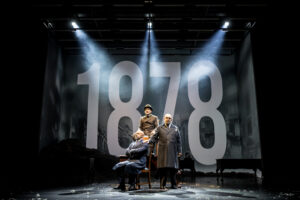 BY KAY SCHROVEN
BY KAY SCHROVEN
This is the story of an industrious, Jewish, immigrant family who attains the American Dream, enjoys its many benefits and over time, experiences its fragility. This masterpiece, which won five Tony awards, including best play, was penned by renowned Italian writer Stefano Massini and adapted by Ben Power (of the National Theater of London.) It is a full blown, 164-year history lesson and epic portrait of the American Dream, told through the experience of one family – the Lehman’s.
Heyman (who becomes Henry) came first, from Bavaria in 1844. He stood on a New York dock at Castle Garden, “suitcase in hand, a circumcised Jew” taking in the expansive view and dreaming of a new life. He is soon joined by his brothers, Mayer and Emanuel, and together they set up a small fabric/dry goods shop in Montgomery, Alabama. The local economy was built on slavery and many clients paid with cotton, which lead the brothers into the business of exporting cotton to the north (New York City.) Over the generations, they expand and become one of the most powerful, international finance firms in the world. We might think of the Lehman Brothers as the first middle-men, the first brokers in America and major contributors to the creation of the stock market. Their business origins were born out of slavery which is shadowed, but not directly addressed in this theatrical presentation.
On stage, the performances of the trio of actors played by Edward Gero, Mark Nelson and William Sturdivant (a local Twin Cities actor) are nothing short of outstanding as they transform in and out of over 60 characters, including generations of Lehmans, their wives, investors, governor, etc. It’s a play that requires your attention – for over three hours. When the play debuted in Paris (2013) it was five hours long! Drink some espresso, down your energy drink and settle in. No napping. It moves rapidly and is completely engaging.
The set is minimal and subtly telling, created by Scenic Designer, Marsha Ginsberg. When the play opens the floor is covered with cotton. As the play evolves, the cotton diminishes, and by the end becomes a pile in a back corner of the stage – like a family heirloom cast off, but not forgotten; a moving symbol that follows the story line. Desks appear, stock market numbers and symbols flash overhead on a screen, as do NYC skylines, newspaper headlines, etc. The brothers integrate into the business world of NYC where big dreams are taking shape in 1858, especially for Henry, Mayer and Emanuel.
The Lehman’s were visionaries creating markets, investing in tobacco, coffee, oil, railroads, and construction, including the Panama Canal, and eventually moving into commodities, investment banking, trading and brokerage. For many years it seemed everything they touched flourished. Over time the Lehman’s realized that they could no longer physically touch their product, – but rather view its synthetic representation in dollars, and abstract symbols. By 2008 they had assets over $600 billion but supported by only 22.5 billion of firm capital. Investopedia reported that the Lehman’s had 639 billion in assets and 619 billion in liabilities.
While serious in subject matter, the play is not lacking in humor and wit. The brothers’ banter, the younger generations acting up. There’s Philip, Bobby and Herbert, challenging their parents with crazy ideas such as investing in computers. “Science fiction!” says the elder. Herbert leaves the family business to enter politics and becomes the 45th governor of New York (1949-1957.) Woven amongst the monologues about the details of business investments are flights of seemingly surrealistic fancy, such as talk about the daring Frenchman, Philippe Petit who became the famous tightrope walker of Paris and New York City, including his 1974 walk between the Twin Towers. In 1975 he fell, so while seemingly irrelevant to the story it becomes a foretelling. Out of nowhere, there’s talk of Noah’s Ark, “They slog like donkeys, weather innumerable tempests (like that pesky war that wipes out their cotton business), build Noah’s Ark but for their company’s sinking ship.”
As the generations evolve and elders die, culture shifts. The Lehman’s experience many culture shifts and realize they need to assimilate. An example, the traditional sitting of Shiva shrinks: first it’s three weeks, then three days and finally a three minute pause at the office for good old what’s his name….. The cotton is gone, the assets are plunging, the tightrope walker fell – everything is changing.
The Lehman’s survived many challenges, war (civil and world), disease, the railroad bankruptcies of the 1880’s, the 1929 stock market crash which led to the Great Depression – but it was the subprime mortgage disaster of 2007-2008 that took them down. Stock prices fell, clients abandoned them, and creditors stopped lending. The firm was illiquid, lacked sufficient collateral to borrow from the Feds or renew contracts. On Sept. 15, 2008 when the Lehman’s finally filed for bankruptcy, stockbrokers committed suicide, 25,000 lost their jobs and were left to sift through the ashes. Ten years later researchers report (in International Business Times, 9/18) an estimate of 6,566 lives were lost due to the collapse, some by suicide. It was the worst financial disaster since the Great Depression.
Director Arin Arbus, debuting at the Guthrie, points out that the play is still relevant today. “It is amazing to be working on it during an election year when this country is fiercely debating its values and when immigration policy is at the center of our national discourse.” The Lehman’s were fleeing oppression. In 19th century Bavaria (Germany) laws, regulations and taxes restricted the life of Jews. In 1844 it was no small feat to make it across the ocean, and create a new life. It took courage, faith, imagination – which met head on with the forces of capitalism. The Lehman family expected capitalism to bend to them, but it did not. It bent everything in its path.
It is a cautionary tale. For some there may be a touch of Freudenschade (sorrow for another’s good fortune.) It is not an ordinary rags to riches story but more a rags to riches to rags story. Sadly, the Lehman’s became hubristic with excessive borrowing and risk taking. Not only did it lead to their downfall but to repercussions felt even today.
On the Wurtele Thrust Stage through Oct. 13. Tickets at 612-377-2224 /
guthrietheater.org






















